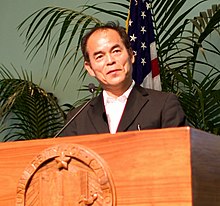Inventor of the blue LED, 2014 Nobel laureate in physics
Shuji Nakamura (中村 修二, Nakamura Shūji, born May 22, 1954) is a Japanese-American electronic engineer and inventor of the blue LED, a major breakthrough in lighting technology.[5] Nakamura specializes in the field of semiconductor technology, and he is a professor of materials science at the College of Engineering of the University of California, Santa Barbara (UCSB).[6]
Together with Isamu Akasaki and Hiroshi Amano, Nakamura received the 2014 Nobel Prize for Physics "for the invention of efficient blue light-emitting diodes, which has enabled bright and energy-saving white light sources". In 2015, his input into the commercialization and development of energy-efficient white LED lighting technology was recognized by the Global Energy Prize. In 2021, Nakamura, along with Akasaki, Nick Holonyak, M. George Craford, and Russell D. Dupuis, were awarded the Queen Elizabeth Prize for Engineering "for the creation and development of LED lighting, which forms the basis of all solid-state lighting technology".[7]
Careers
Nakamura graduated from the University of Tokushima in 1977 with a B.Eng. degree in electronic engineering, and obtained an M.Eng. degree in the same subject two years later, after which he joined the Nichia Corporation, also based in Tokushima. It was while working for Nichia that Nakamura invented the method for producing the first commercial high brightness gallium nitride (GaN) LED whose brilliant blue light, when partially converted to yellow by a phosphor coating, is the key to white LED lighting, which went into production in 1993.
Previously, J. I. Pankove and co-workers at RCA put in considerable effort but did not make a marketable GaN LED in the 1960s. The principal problem was the difficulty of making strongly p-type GaN. Nakamura drew on the work of another Japanese group led by Professor Isamu Akasaki, who published their method to make strongly p-type GaN by electron-beam irradiation of magnesium-doped GaN; however, this method was not suitable for mass production. Nakamura developed a thermal annealing method that was much more suitable for mass production. In addition, he and his co-workers worked out the physics and pointed out the culprit was hydrogen, which passivated acceptors in GaN.
At the time, many considered creating a GaN LED too difficult to produce; therefore, Nakamura was fortunate that the founder of Nichia, Nobuo Ogawa [ja] (1912–2002), was willing to support and fund his GaN project.[11] However, the senior Ogawa ceded the presidency to his son-in-law Eiji Ogawa (in 1989). The company under Eiji's direction ordered him to suspend work on GaN, claiming it was consuming too much time and money.[14] Nakamura continued to develop the blue LED on his own and in 1993 succeeded in making the device.[14]
Despite these circumstances, once Nakamura succeeded in creating a commercially viable prototype, 3 orders of magnitude (1000 times) brighter than previously successful blue LEDs, Nichia pursued developing the marketable product.[11] The company's gross receipt surged from just over ¥20 billion (≈US$200 million) in 1993 to ¥80 billion (≈US$800 million) by 2001, 60 percent of which was accounted for by sales of blue LED products.[14] The company's workforce doubled between 1994 and 1999 from 640 to 1300 employees.
Nakamura was awarded a D.Eng. degree from the University of Tokushima in 1994. He left Nichia Corporation in 1999 and took a position as a professor of engineering at the University of California, Santa Barbara.
In 2001, Nakamura sued his former employer Nichia over his bonus for the discovery as a part of a series of lawsuits between Nichia and Nakamura with Nichia's US competitor Cree Inc.; they agreed in 2000 to jointly sue Nichia at the expense of Cree and Nakamura received stock options from Cree. Nakamura claimed that he received only ¥20,000 (≈US$180) for his discovery of "404 patent," though Nichia's president Eiji Ogawa's side of the story was that he was shocked beyond belief that the court would award Nakamura ¥20 billion, and downplaying the significance of the "404 patent," opined that the company had adequately compensated him for the innovation through promotions and bonuses amounting to ¥62 million over 11 years and annual salary which was raised to ¥20 million by the time Nakamura quit Nichia.[18]
Nakamura sued for ¥2 billion (<US$20 million) as his fair share for the invention, and the district court awarded him ten times the amount, ¥20 billion (<US$200 million). However, Nichia appealed the award and the parties settled in 2005 for ¥840 million (≈US$8.1 million, less than 5% of the award amount), which was still the largest payment ever paid by a Japanese company to an employee for an invention,[19] an amount only enough to cover legal expenses incurred by Nakamura.[21]
Nakamura has also worked on green LEDs and is responsible for creating the white LED and blue laser diodes used in Blu-ray Discs and HD DVDs.[22]
Nakamura is a professor of Materials at the University of California, Santa Barbara.[23] In 2008, Nakamura, along with fellow UCSB professors Dr. Steven DenBaars and Dr. James Speck, founded Soraa, a developer of solid-state lighting technology built on pure gallium nitride substrates.[24] Nakamura holds 208 US utility patents as of 5 May 2020.[25]
In November 2022, Nakamura co-founded Blue Laser Fusion, a commercial fusion company, with Hiroaki Ohta, a former president of Tokyo-based drone maker ACSL.[26] In July 2023, Blue Laser Fusion raised $25 million from venture capital firm JAFCO Group and the Mirai Creation Fund, which is backed by Toyota Motor and other investors and managed by the SPARX Group.[26]
Personal
Nakamura is married to Yuki Nakamura.[27]
